What is Rose Rust?

Rose rust is a fungal disease that can affect the leaves, stems, and canes of rose plants. It is caused by several species of fungi in the Phragmidium genus, particularly Phragmidium tuberculatum and Phragmidium mucronatum.
How Does Rose Rust Affect Roses?

Symptoms of Rose Rust Infection
- Leaves: Yellow spots on the upper surface, orange or rust-colored pustules on the underside that turn black in late summer, and premature leaf drop.
- Stems: Distorted young green stems with large pustules of bright orange dusty spores, and galls and lesions on canes.
- General: The disease typically starts on the lower foliage and moves upwards, causing defoliation, wilting, and reduced plant vigor.
Impact on Plant Health
Rose rust can weaken and distort rose growth, but it rarely kills the plant outright. However, severe infections can lead to complete defoliation, which affects the plant’s ability to produce and store energy, resulting in poor growth and reduced flowering.
What is the Life Cycle of Rose Rust Fungi?
- Spring Spores: Infect young stems, causing distortion and the production of bright orange pustules, which then infect leaves to produce summer spores.
- Summer Spores: Produced on the underside of leaves, these spores are spread by wind and initiate further infections, requiring prolonged periods of leaf wetness for infection.
- Resting Spores: Formed in late summer, these dark, tough spores overwinter on fallen leaves, stems, or trellises, and initiate new infections in the spring.
What Environmental Conditions Promote Rose Rust Growth?
- Moisture: Infection requires moisture on the leaves for 2 to 4 hours.
- Temperature: Optimal temperature for infection is between 59°F and 70°F.
- Humidity: High humidity favors the spread of the disease.
How Can Rose Rust Be Treated and Prevented?
Treatment Options
- Pruning: Remove and destroy infected leaves and canes as soon as they are detected to prevent the spread of spores.
- Fungicides: Use fungicides containing sulfur, copper, mancozeb, or Bacillus subtilis. Neem oil can also be effective. Apply fungicides early in the spring when the first orange spots appear, and repeat applications as necessary.
Preventative Measures
- Plant Selection: Choose rose varieties that are resistant to rust and other fungal diseases.
- Good Cultivation Practices: Ensure proper planting, spacing, pruning, and watering to promote dry conditions around the plants. Avoid overhead watering and use drip irrigation or soaker hoses instead.
- Sanitation: Collect and destroy fallen leaves in autumn to reduce overwintering spores, and sanitize tools, clothing, and hands after touching infected plant materials.
- Environmental Management: Improve air circulation around the canopy by pruning or spacing plants, and avoid working with roses when the foliage is wet.
In summary, while rose rust can weaken and distort rose growth, it rarely kills the plant outright. Proper management, including cultural practices, sanitation, and the use of fungicides, can help control the disease and prevent it from causing significant damage to your rose plants.
Reference:
[1] RHS Gardening: Rose rust / RHS Gardening
[2] Gardener’s Path: How to Identify and Treat Rose Rust | Gardener’s Path
[3] SDSU Extension: Rose Rust – SDSU Extension – South Dakota State University
[4] Missouri Botanical Garden: Rose Rust – Missouri Botanical Garden
[5] University of California Agriculture and Natural Resources: Rose Rust – UC IPM
